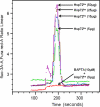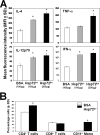Chaperokine function of recombinant Hsp72 produced in insect cells using a baculovirus expression system is retained
- PMID: 19861412
- PMCID: PMC2804182
- DOI: 10.1074/jbc.M109.024612
Chaperokine function of recombinant Hsp72 produced in insect cells using a baculovirus expression system is retained
Abstract
Extracellular heat shock protein 72 (Hsp72; inducible form of the 70-kDa heat shock protein) plays a critical role in innate and adaptive immune responses and has shown promise as an ideal adjuvant for the optimization of antigen-specific anti-tumor vaccines. Recent studies suggest that to correctly elucidate the mechanisms by which Hsp72 exerts its beneficial effects in vitro, great care must be taken to ensure that endotoxin by-products do not invalidate the findings. In this study, we have taken advantage of the baculovirus expression vector system for production of endotoxin-free recombinant Hsp72. The coding sequence of human hsp72 was recombined into the baculovirus immediately downstream of the strong polyhedron gene promoter. Ninety-six h post-infection of Sf9 insect cells with recombinant baculovirus, maximal levels of Hsp72 protein were detected. The recombinant human Hsp72 was purified by affinity chromatography from insect cells, and purity was confirmed by SDS-PAGE and mass spectrometry. The purified human recombinant Hsp72(bv) (Hsp72 produced using the BEVS) was demonstrated to have no endotoxin contamination and was shown to have stimulated potent calcium flux in the human monocytic cell line. Furthermore, recombinant Hsp72(bv) enhanced the tolerance of neuroblastoma cells to heat stress-induced cell death and displayed classical chaperokine functions including augmentation of inflammatory cytokine productions in mouse splenocytes. The production of functional, endotoxin-free recombinant human Hsp72(bv) in insect cells is inexpensive and convenient and eliminates the need of special procedures for endotoxin depletion. Endotoxin-free recombinant human Hsp72(bv) can now be used to unlock the important role Hsp72 plays in modulating immune function.
Figures







References
-
- Hartl F. U. (1996) Nature 381, 571–579 - PubMed
-
- Lindquist S., Craig E. A. (1988) Annu. Rev. Genet. 22, 631–677 - PubMed
-
- Asea A. (2008) Novartis. Found. Symp. 291, 173–179; discussion 291, 179–183 - PubMed
-
- Asea A. (2007) in Heat Shock Proteins: Potent Mediators of Inflammation and Immunity (Asea A., De Maio A. eds) Vol. 1, pp. 3–20, Springer Publishers, Dordrecht, The Netherlands
Publication types
MeSH terms
Substances
Grants and funding
LinkOut - more resources
Full Text Sources
Other Literature Sources

